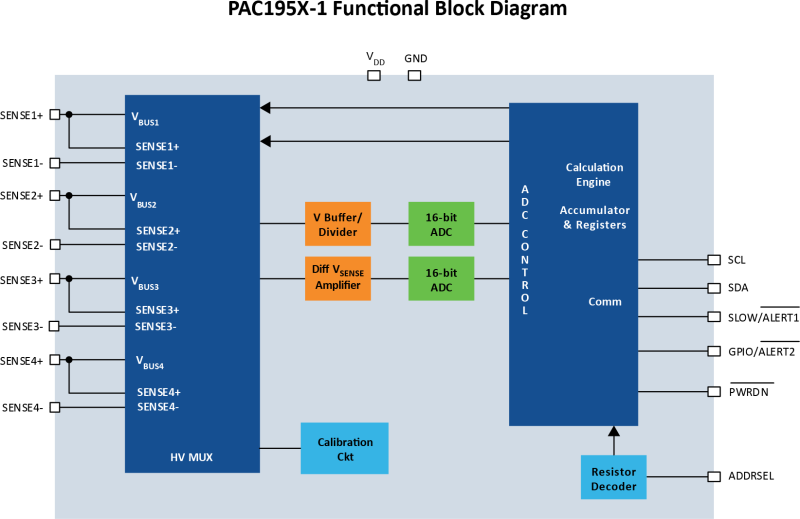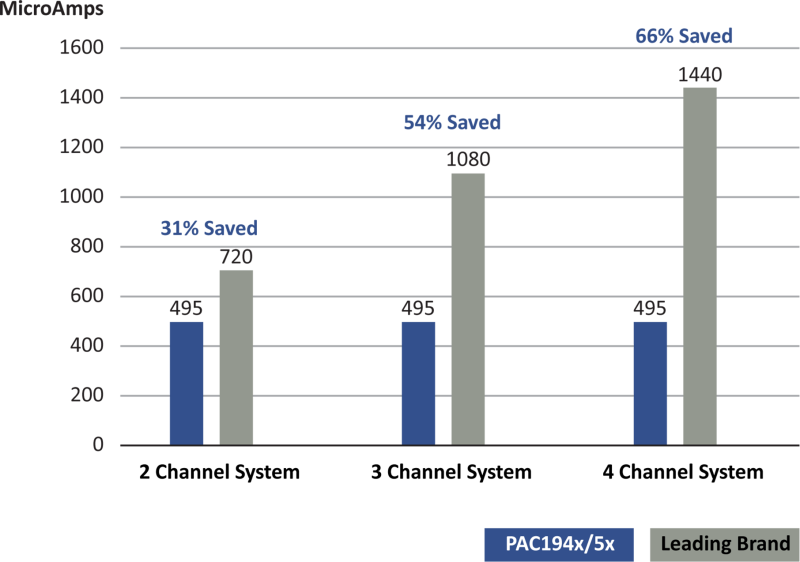Capturing and Responding to Power Events: Two New Precision Power Monitor Families for Computing, Portable Electronics, Optoelectronics and Data Centers
The PAC194x and PAC195x multichannel precision power monitor families improve upon the PAC193x with two alert outputs for event detection of over-current, over-voltage, over-power, under-voltage and under-current. Where a 0 to 32V family has existed, the new generation also includes a 0 to 9V family (PAC194x) to focus on portable power applications for 1- to 2- cell litium-ion battery monitoring.
As an industry leader in precision multichannel current / power monitors with 16 bits of resolution, our multichannel devices have a dual analog to digical converter (ADC) architecture that allows voltage and current to be measured simultaneously for a measurement of true power, which is not available with other power monitors. While there are plenty of single-channel current/power monitors available there are very few multichannel solutions. Let’s explore this solution for lowering cost, lowering power and simplifying the system design.
Two new current/power monitoring families are available – the PAC194x (0 to 9V) and PAC195x (0 to 32V), which build on 16-bit dual ADC architecture and add two alert outputs for power related event detection. Power management engineers can use these new families to:
- Overcome high power consumption that occurs with current / power monitors
- Use the multiple alerts to facilitate flexible power event detection
- Employ low input impedance to enable flexible sense resistor placement
- Specificically add solutions targeted for single and dual cell lithium ion batteries

Managing power more efficiciently is critical but the reasons differ by industry. For example, by one account data centers worldwide account for 1% of all global energy consumption (energyinnovation.org ). As such the cost of ownership for data centers becomes the cost of utilities once equipment is depreciated. Check out this link for more about data center usage.. More efficient measurement tools allow for better management of power that ultimately allows for lower energy usage and lower cost
Many optical networking applications measure power in the optical transceiver modules used for long-haul, inter-metro connections and data center networking. These modules are limited for space and need a precision current-sense measurement to monitor the avalanche photo diode and assist the system host controller in setting the link brightness. Here better measurement equates to a better control loop.
And finally, developers of portable electronics require better ways to manage limited power for an application. More efficient use of power means an extension of operational time before additional charging is required – and that is a strong point for consumers.
The PAC194x and PAC195x families save system power when measuring the power in multiple voltage rails. In comparison to using two single channel devices, a PAC1942 or PAC1952 (both two-channel devices) consume 31% less power. Speficially, a two-channel PAC1942 or PAC1952 monitor consumes 495 uA max at 125C, whereas two single-channel devices can consume 720 uA.
 Where power event detection is concerned, the two new families each provide two independent alert outputs that can be used for over-voltage, over-current, over-power, under-current and under-voltage. These independent outputs enable you to dedicate one alert to separate subsystems needing monitoring. Likewise, you can dedicate one alert to voltage events and one alert to spurious current events for a different type of system detection. Hence, with flexible masking of alerts on each output, a system designer can customize the event detection scheme.
Where power event detection is concerned, the two new families each provide two independent alert outputs that can be used for over-voltage, over-current, over-power, under-current and under-voltage. These independent outputs enable you to dedicate one alert to separate subsystems needing monitoring. Likewise, you can dedicate one alert to voltage events and one alert to spurious current events for a different type of system detection. Hence, with flexible masking of alerts on each output, a system designer can customize the event detection scheme.
Another pain point for developers that can be avoided relates to component placement and error due to trace length. Today other device providers need to place their current/power monitor integrated circuits (ICs) close to the sense resistor or suffer additional measurement error. Not so with the PAC194x and PAC195x. These new families of devices allow long traces to connect the sense resistors to the IC – and therefore alleviate board spacing constraints on densely packed PCBs while maintaining a high accuracy.
Finally, power management detection often has been created with higher voltages in mind – for example, 16V and above. That ignores the ever-growing segment of sytems that exist at 9V and under for power. A dual-cell lithium-ion battery has a maximum need for 9V of system power monitoring. The PAC194x family of multichannel power monitors was tailored to provide 16-bit precision power management from 0 to 9V and fill that need. In addition, the PAC194x family can be configured to monitor single cell applications at 0 to 4.5V while still maintaining precision for measuring voltage and current.
So how can you learn more and take advantage of these new PAC194x and PAC195x precision multichannel power monitor families? Visit our product page to learn more about the PAC1944 0 to 9V power monitor or PAC1954 for the 0 to 32V power monitor.
Video on the device families can be found here.
EVBs for both device families can be found on the product pages.
.png)
